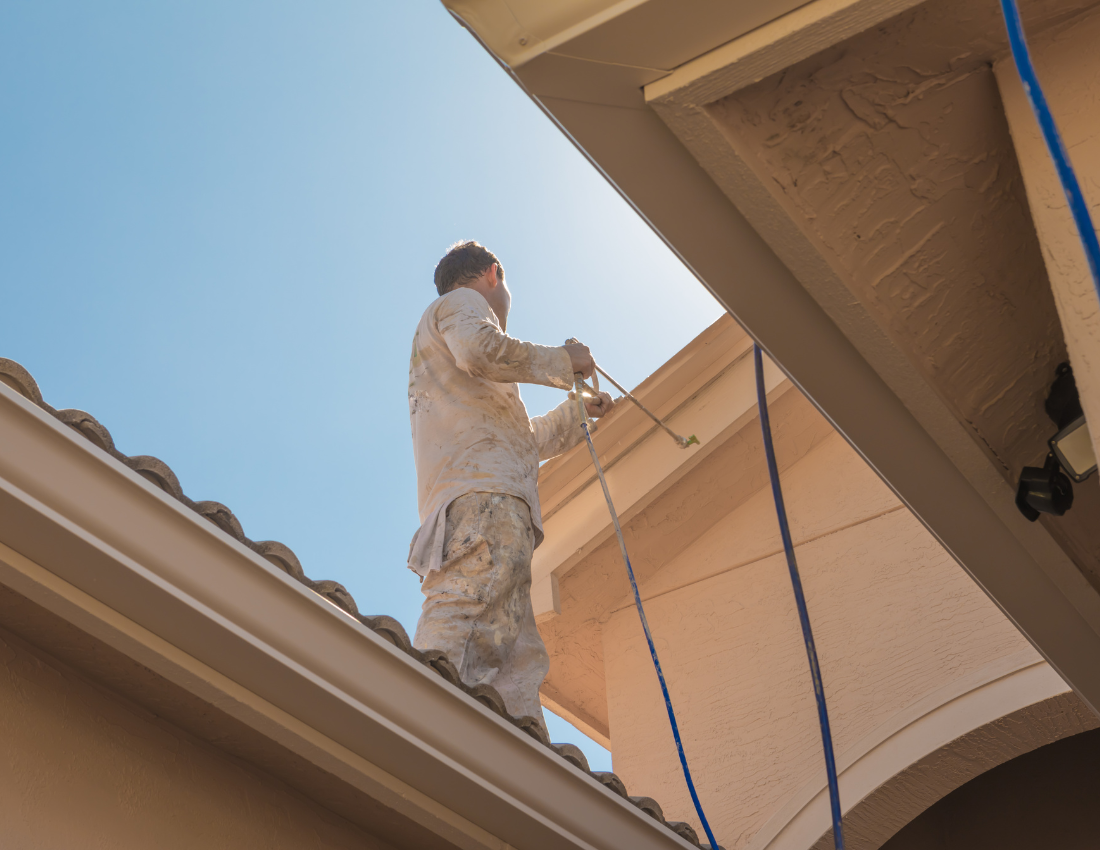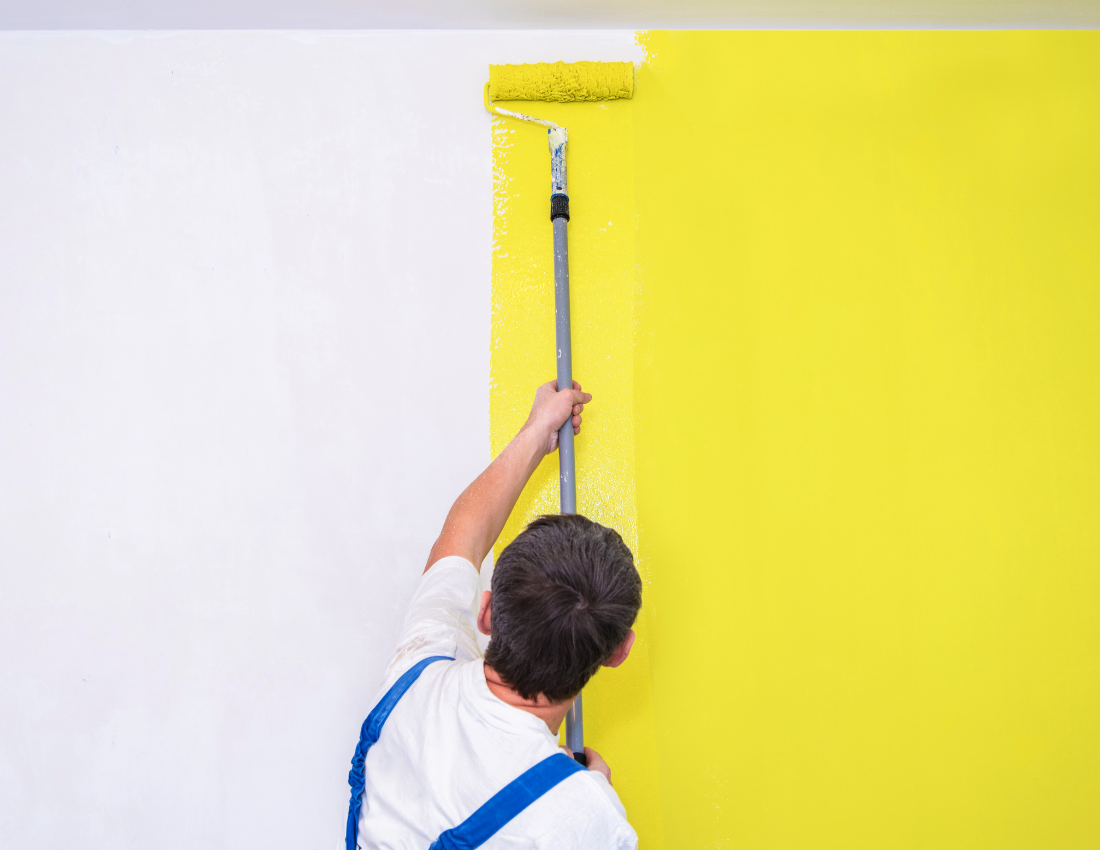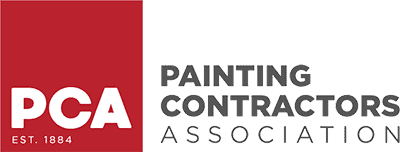Thinking about painting your home, furniture, or ceilings? One of the biggest decisions you’ll make is choosing between roller painting vs spray painting. This choice can affect how long the project takes, the finish quality, and even how much paint you’ll need.
Some homeowners love paint sprayers because they cover large surfaces quickly, creating a sleek, smooth finish. Others stick to paint rollers for their ability to provide better adhesion and control, especially on interior walls and ceilings.
But which one is right for your home improvement project?
Whether you’re freshening up a living room, painting kitchen cabinets, or tackling exterior stucco, knowing when to use a sprayer vs. a roller makes all the difference. Professional house painters in Leesburg, VA use both methods depending on the house painting project, and today, we’ll break down the benefits, challenges, and best use cases for each.
Key Takeaways:
- Roller painting vs spray painting depends on the size of the project, surface type, and level of detail needed.
- Sprayers are best for large surfaces, textured walls, and intricate details, providing a smooth, factory-like finish but requiring extensive prep work and more paint usage.
- Rollers offer better control, less paint waste, and easier application, making them ideal for interior walls, ceilings, and budget-friendly projects.
- Sprayers work well for exterior painting, masonry, and furniture refinishing, while rollers are more practical for occupied spaces and smaller home improvement tasks.
- Beginners will find rollers easier to handle, whereas sprayers require skill and practice to avoid drips, streaks, and uneven coats.
When Spray Painting Is the Right Choice
Paint sprayers work by using compressed air or high-pressure pumps to turn paint into a fine mist that evenly coats surfaces. This method is ideal for large spaces, textured walls, and intricate details that are hard to reach with a roller.
Covers Large Areas Quickly
If you’re painting garage doors, exterior brick, stucco walls, or fences, a paint sprayer is the fastest option. Unlike a paint roller or brush, which requires multiple strokes and reloads, sprayers provide continuous coverage in a fraction of the time.
But keep in mind—speed comes with preparation. Since sprayers create overspray, you’ll need to mask off floors, windows, baseboards, and furniture with plastic sheeting or drop cloths to avoid unwanted paint mist settling on unintended surfaces.
Best for Textured and Detailed Surfaces
Sprayers shine when painting surfaces with deep grooves, intricate molding, or hard-to-reach corners. They work especially well on:
- Popcorn ceilings & textured walls. A sprayer evenly coats rough surfaces, avoiding uneven patches.
- Masonry & brick. Paint settles into crevices that rollers can’t reach.
- Crown molding, baseboards & dentil trim. Fine details are evenly covered without brush strokes.
If you’re dealing with a popcorn ceiling or textured wall, check out how many coats of paint for interior walls for tips on achieving full coverage.
Creates a Factory-Finish Look on Furniture & Cabinets
If you’re painting kitchen cabinets, furniture, or built-in shelves, a sprayer provides the smoothest, most professional-grade finish. Rollers and brushes can leave streaks or uneven textures, but a sprayer lays down an even acrylic paint or oil-based paint coat without brush marks.
That said, spray painting indoors requires proper ventilation. Using a mask and personal protective equipment is essential, especially for oil-based paints, primers, and waterproofing sealers.
Challenges of Spray Painting
While spray painting is an efficient way to achieve a smooth, professional finish, it comes with its own set of challenges. Extensive prep work, higher paint usage, and the need for experience can make it less ideal for beginners or certain home projects. Here’s what you should know before picking up a paint sprayer.
Requires Extensive Masking & Setup
One of the biggest downsides of spray painting is the time-consuming prep work. Unlike a paint roller, which applies paint only where you roll, a sprayer disperses fine mist particles into the air. This means anything that isn’t meant to be painted—floors, furniture, baseboards, windows, doors, carpets, and even ceiling fans must be completely covered with plastic sheeting, painter’s tape, or drop cloths.
For indoor projects, this level of preparation can be overwhelming. If you’re painting a single wall or a small room, the time spent masking could outweigh the time saved spraying.
Outdoor spray painting also requires careful setup. If you’re painting garage doors, stucco, or exterior brick, wind can carry the paint mist onto windows, landscaping, or even neighboring houses, which means even more masking and protection.
While house painters in Leesburg VA have the experience to mask efficiently, DIY homeowners may find this prep work tedious and time-consuming. If you want a faster, more controlled application without spending hours taping and covering surfaces, roller painting may be the better choice.
Uses More Paint
A paint sprayer uses more paint compared to a roller or brush, and some of it is lost in the air during application. This overspray can cause you to go through paint quicker than expected, meaning you’ll need extra gallons to complete your project—raising material costs.
Here’s why sprayers increase paint consumption:
- Some paint particles never reach the surface, floating into the air instead.
- More coats may be needed to ensure even coverage.
- Absorbent surfaces like drywall or stucco can soak up the mist, requiring extra layers.
This can be especially noticeable when using oil-based paint, primer, or waterproofing products, where every drop matters. If you’re working within a budget, roller painting might be the more cost-effective choice because it applies paint directly onto the surface without waste.
Takes Skill & Experience
Using a paint sprayer isn’t as simple as just pulling the trigger and painting away. Proper technique is required to avoid drips, streaks, or uneven coverage, which can leave a splotchy, unprofessional finish.
Common mistakes beginners make when spray painting include:
- Holding the nozzle too close. This can cause thick, uneven layers that drip.
- Holding the nozzle too far. This results in a thin, patchy coat that may require multiple layers.
- Inconsistent pressure settings. Adjusting the sprayer incorrectly can lead to over-application in some areas and light coverage in others.
Unlike a paint roller, which is beginner-friendly, sprayers require practice to master. If you’ve never used one before, it’s best to test it out on a scrap surface first before tackling walls, ceilings, cabinetry, or furniture.
When Roller Painting Is the Best Option
A paint roller is the go-to tool for many interior and exterior painting projects. It applies paint directly to the surface, ensuring better adhesion, control, and less waste.
Provides More Control with Less Mess
If you’re painting a living room, bedroom, or basement, a roller is easier to handle and keeps paint where you want it. Unlike sprayers, which require full-room masking, rollers only need basic protection for floors, furniture, and baseboards.
Better for Budget-Friendly Projects
Because paint rollers use paint more efficiently, they help reduce costs. Sprayers waste some paint through overspray, while rollers transfer every drop directly onto the wall. This is especially important when using high-end acrylic paint, oil-based paint, or primers—where getting full coverage without wasting material matters.
We’ve already discussed the differences between oil-based paint vs water-based paint to help you choose the right type for your project. If you’re working on a budget or want a durable finish, knowing which type works best for your walls, cabinetry, or trim can make a big difference.
Rollers also don’t require nozzles, hoses, or compressed air pumps, keeping equipment expenses low while still delivering a solid, even coat.
Ideal for Interior Walls, Ceilings & Small Projects
For occupied spaces, accent walls, and quick touch-ups, a roller is the most practical choice. It also gives you the freedom to pause and resume painting later, unlike sprayers, which require continuous work.
Looking for interior design inspiration? Check out house painting trends for color ideas that can modernize your home.
Challenges of Roller Painting
While roller painting is a reliable and cost-effective method, it does have some drawbacks. It requires more manual effort, takes longer on large surfaces, and isn’t the best fit for textured materials. Here’s what you need to know before choosing a roller for your next project.
Takes More Time
If you’re painting a large surface, like a garage door, basement walls, or masonry, be prepared for a time-consuming process. Unlike a sprayer that covers a broad area in a single pass, a paint roller requires multiple strokes and frequent reloads in the paint tray.
For example:
- Painting a garage door with a roller could take several hours, while a sprayer could cut that time in half.
- Covering concrete or masonry walls can require multiple coats, as rollers don’t always push paint deep into crevices.
- Rolling exterior stucco takes longer because the roller must be worked into the texture to avoid uneven coverage.
If time is a concern, a sprayer is the faster option. However, if you don’t mind the extra effort and prefer more control over paint application, using a roller may still be a good choice especially for interior walls or smaller areas.
Not Ideal for Rough or Textured Surfaces
Rollers work well on smooth walls, but they struggle to cover deep grooves and rough textures. Surfaces like:
- Stucco
- Popcorn ceilings
- Brick and masonry
- Rough wood paneling
…can be challenging to paint with a roller. The roller may glide over the surface without pushing paint into all the nooks and crevices, leaving behind uneven coverage. To get full coverage on these types of surfaces, you may need multiple coats or a high-nap roller, which is designed to hold more paint and reach deeper textures.
That said, if you’re painting a deeply textured surface, using a sprayer might be a better option since it allows the paint to settle evenly into crevices.
Requires More Physical Effort
Roller painting is a hands-on process that requires consistent movement and repetitive strokes. While this may not be an issue for smaller projects, painting ceilings, tall walls, or entire rooms with a roller can be physically tiring.
What makes it more demanding?
- Overhead work. Painting ceilings or high walls requires lifting your arms for extended periods, which can lead to fatigue.
- Using an extension pole. While this can help reach tall spaces, it requires more effort to control the roller.
- Multiple coats. If the surface needs two or more coats, rolling can become more labor-intensive compared to spraying.
For homeowners tackling large-scale projects, a sprayer reduces physical strain and speeds up the process. However, if you prefer a controlled application, a roller is still a great option—just be prepared for the extra effort required to complete the project.
Roller Painting vs Spray Painting: Side-by-Side Comparison
| Spray Painting | Roller Painting | |
|---|---|---|
| Speed | Fast, covers large areas quickly | Slower, requires multiple coats |
| Finish | Smooth, factory-like, best for furniture & cabinets | Even coverage, slight texture |
| Paint Efficiency | Uses more paint due to overspray | Uses less paint, cost-effective |
| Prep Work | Requires extensive masking | Minimal masking required |
| Best For | Large spaces, textured surfaces, detailed molding | Interior walls, ceilings, occupied spaces |
If you’re painting a large outdoor area, intricate woodwork, or furniture, a paint sprayer is a great choice. If you’re painting a room inside your home, a paint roller is the better, more efficient option.
Our Painting Process & How We Can Help
At Appaloosa Painting Co., we offer professional painting services that ensure a flawless finish, whether you choose roller painting or spray painting.
- Surface Preparation: We clean, sand, and repair drywall, wood, masonry, and plaster for the best results.
- Expert Masking & Protection: We cover floors, windows, baseboards, and furniture to prevent unwanted paint splatter.
- Skilled Application: Our professional painters use the right method—rollers, sprayers, or paintbrushes—for each surface.
- Final Touch-Ups & Cleanup: We leave your space looking fresh, polished, and mess-free.
Serving Purcellville, Ashburn, VA, and the surrounding areas. Call us at 540-202-7600 for a FREE estimate today!




